When we drove from Souillac into the Dordogne department, one of the first villages we saw was La Roque-Gageac. It's right on the Dordogne river, and it's actually a kind of miniature Rocamadour — a village clinging to the face of a rock cliff. Our gîte was just a couple of miles up the road from La Roque-Gageac.
The village has a population of fewer than 500 people. Like many of the towns we saw in the Dordogne, it has been quite thoroughly "prettied up" for tourists. At least that's my impression. Everything was just slightly Disney-esque, I thought. Napa Valley sprang to mind, also, as we drove down the Dordogne river valley. It would be hard to say it's too pretty, but I found myself wondering what all these towns looked like 50 or 100 years ago.
As my Michelin Green guide for Périgord and Quercy, dated 1986, says, of La Roque-Gageac, "le village a été restauré" — the village has been restored. But then most villages that are 500 or 1000 or 1500 years old have been restored many times over the course of their history.
The Cadogan guide mentions the "effect of a two-dimensional stage set" in its description of La Roque-Gageac. The "warm stone houses and their brown roofs are piled so harmoniously against [an overhanging cliff] that they hardly seem real," Cadogan continues. It would be hard to disagree with that assessment.
It's all very photogenic, and Sue, Walt, and I do love to take pictures. We spent not more than an hour climbing around the town, and dozens... scores... hundreds... of pictures resulted. A good time was had by all. It was a beautiful Friday afternoon and we hadn't even arrived at our gîte yet. Isn't digital photography wonderful?
I liked the red camionnette ("trucklet" or mini-van, I guess we might say) in this picture. It had the name of restaurant on its rear end. The phone number painted on the hatch has just six digits. Currently, French phone numbers are up to 10 digits, so this was old advertising on an old Renault vehicle.
The views from the paths and stairs in the upper village are pretty, for sure. You feel like it might all tumble into the river at any moment, taking you with it. Maybe that's my California earthquake fear talking, three years later.
Looking down, you also get glimpses of café terraces, with tables where people are enjoying a quiet, sunny moment and a drink. It's all very pleasant and peaceful.
At the west end of the village stands the imposing Château de la Malartrie. I just noticed that the Cadogan guide describes it as "a convincing reconstruction of the 15th-century original." And the Michelin guide adds: "Cet édifice n'a été construit qu'au début du 20e siècle en s'inspirant très fortement du style du 15e s." — the castle was built at the beginning of the 20th century and was greatly inspired by 15th-century-style architecture. I don't think Walt Disney had yet been born at the beginning of the 20th century, had he? [NB: Disney was born in 1901.]
Here's something natural and authentic I saw in La Roque-Gageac: flowers. Very pretty ones. The village, built on a south-facing stone cliff-side, benefits from a warm micro-climate that encourages plants, including tropical varieties, to grow profusely.
In La Roque-Gagac, Cadogan says, "reality does intrude occasionally, when bits from the huge cliff break off and fall like meteors through the roofs" of the harmoniously piled-up houses. That explains why the place has had to be restored and reconstructed, I guess.

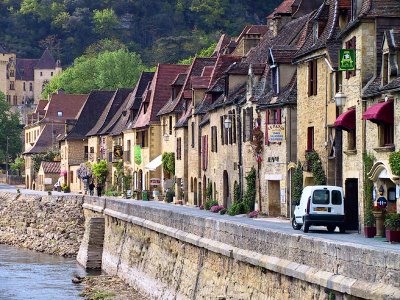
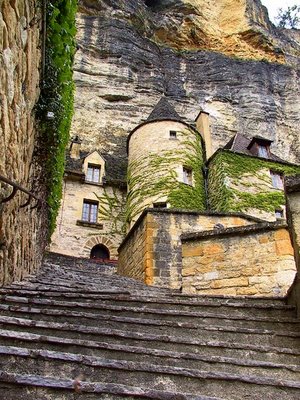
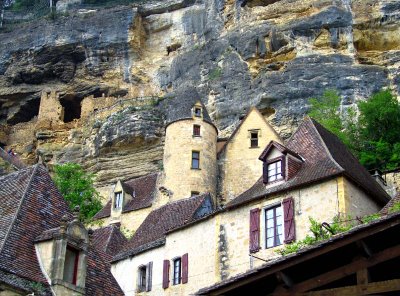
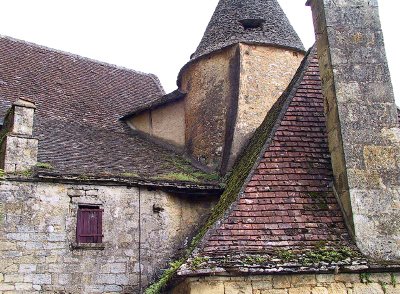

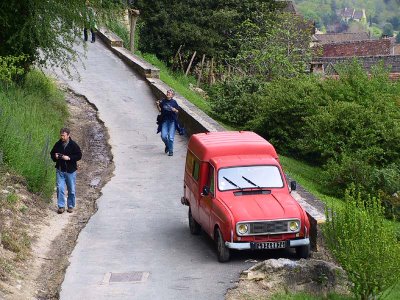



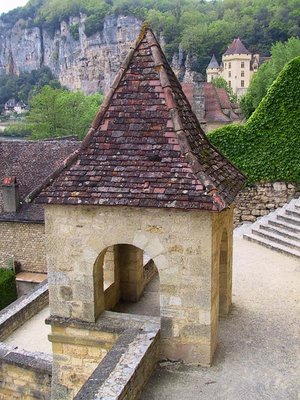
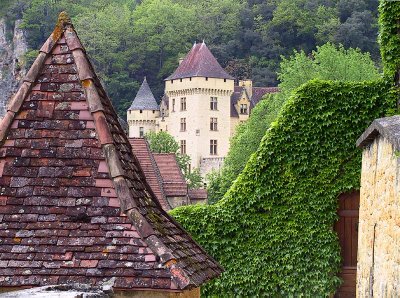

I loved your write-up of this village, one of my favorites in the Dordogne, which is in turn one of my favorite areas in France -- and one I go to fairly often. I can't wait to read the other blogs about your stay!
ReplyDeleteI'm so glad the three of you all love to take pictures, and we get to benefit.
ReplyDelete